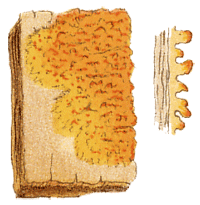|
What is a lichen?
What's not a lichen
It's easy to mistake some other organisms for lichens when you are just beginning to learn about the latter. After a while you begin to recognize some of the commoner 'look-alikes' in the field but occasionally even a lichenologist may be unsure and need to check microscopically.
This page will deal briefly with some of these other cryptogam groups that you might confuse with lichens. This page won't tell you how to tell them apart from lichens. Sometimes it's very easy, sometimes it's not. Rather, the aim is to make you aware of these other organisms.
Non-lichenized fungi
Sometimes it takes a bit of effort to determine whether you have a lichen (also called a lichenized fungus) or a non-lichenized fungus in front of you. After all, they are all in the fungal kingdom so you must expect strong similarities between some lichenized and some non-lichenized fungi (which are dealt with on the Australian National Botanic Gardens' fungal website ). In the BASIDIOLICHENS the fungus and the photobiont are typically not as tightly bound into one thallus as are the great majority of ascolichens so, for example, it would be understandable to think of Lichenomphalia chromacea ![]() as an independent mushroom, rather than as a basidiolichen fruiting body, associated with the alga growing on the nearby soil. So, is any small mushroom growing on algal covered soil also a basidiolichen fruiting body? Perhaps, perhaps not. You can find non-lichenized fungi growing on soil amongst free-living algae. Similarly, you can find non-lichenized apothecial and perithecial ascomcyetes growing amongst algae on wood.
as an independent mushroom, rather than as a basidiolichen fruiting body, associated with the alga growing on the nearby soil. So, is any small mushroom growing on algal covered soil also a basidiolichen fruiting body? Perhaps, perhaps not. You can find non-lichenized fungi growing on soil amongst free-living algae. Similarly, you can find non-lichenized apothecial and perithecial ascomcyetes growing amongst algae on wood.
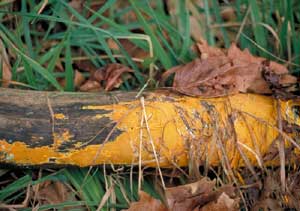 On the right is an example of a non-lichenized corticioid fungus. The fruiting body of a corticioid fungus is two-dimensional and looks much like an extra skin on the woody substrate. How can you tell this is a non-lichenized fungus and not a sterile crustose lichen? Experience helps but even for the experienced there are times when the only way to be sure is to examine a fragment under the microscope to see if there are just fungal hyphae in such a sheet-like growth, or are photobiont cells also present. Many species of corticioid fungi grow only on the underside of long-dead wood that is lying on the ground. The log in the picture has been rolled over and the yellow corticioid fungus had been growing on the underside of this log. Lichens need access to light and could not grow on the underside of much of the fallen, dead wood you can see in forests and woodlands. Some corticioid species can be found on trunks or branches of live trees and then the job of distinguishing them from lichens can take more effort. However, lichens are far more common on such substrates than are the corticioid fungi. Some of the upright fruticose lichens are highly branched and so look rather coral-like. There are also many species of coral-like un-lichenized fungi. While many of those are fleshy and pliable there are also some with a firmer consistency and so more lichen-like.
On the right is an example of a non-lichenized corticioid fungus. The fruiting body of a corticioid fungus is two-dimensional and looks much like an extra skin on the woody substrate. How can you tell this is a non-lichenized fungus and not a sterile crustose lichen? Experience helps but even for the experienced there are times when the only way to be sure is to examine a fragment under the microscope to see if there are just fungal hyphae in such a sheet-like growth, or are photobiont cells also present. Many species of corticioid fungi grow only on the underside of long-dead wood that is lying on the ground. The log in the picture has been rolled over and the yellow corticioid fungus had been growing on the underside of this log. Lichens need access to light and could not grow on the underside of much of the fallen, dead wood you can see in forests and woodlands. Some corticioid species can be found on trunks or branches of live trees and then the job of distinguishing them from lichens can take more effort. However, lichens are far more common on such substrates than are the corticioid fungi. Some of the upright fruticose lichens are highly branched and so look rather coral-like. There are also many species of coral-like un-lichenized fungi. While many of those are fleshy and pliable there are also some with a firmer consistency and so more lichen-like.
Note that some longer-lasting fungal fruiting bodies can support algal colonies. On the upper, slightly hairy surface of this Trametes fruiting body ![]() you can see a good growth of green alga. This is coincidental, not the sign of a symbiotic association. The slightly hairy upper surface of this Trametes is effective at trapping and holding moisture, thereby creating good conditions for algal growth. Moreover these leathery Trametes fruiting bodies have a low water content and so do not decay rapidly, thereby giving time for a good sized algal colony to develop.
you can see a good growth of green alga. This is coincidental, not the sign of a symbiotic association. The slightly hairy upper surface of this Trametes is effective at trapping and holding moisture, thereby creating good conditions for algal growth. Moreover these leathery Trametes fruiting bodies have a low water content and so do not decay rapidly, thereby giving time for a good sized algal colony to develop.
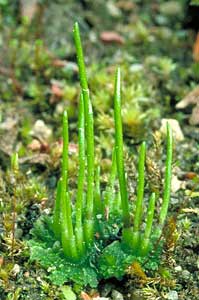 Hornworts and thallose liverworts
Hornworts and thallose liverworts
Hornworts and liverworts belong to a group of organisms called bryophytes, which are in the plant kingdom and so are quite distinct from anything fungal. There's more about bryophytes on the Australian National Botanic Gardens' bryophyte website, where you can find detailed information about hornworts and thallose liverworts. Hornworts and thallose liverworts have a vegetative growth form akin to that of some foliose lichens and those two groups of bryophytes may produce additional structures that could be mistaken for apothecia.
Here (right) is a photo of a hornwort. Growing along the ground is a flat, green sheet, often lobed just like a foliose lichen. The upright 'horns' that give rise to the name 'hornwort' are called sporophytes and will produce spores. Before the sporophytes develop, a hornwort is just a flattish growth which you might mistake for a sterile, foliose lichen. As the spores mature in a hornwort sporophyte the sporophyte turns brown, starting from the top and progressing downwards. Some lichens also have brown-tipped, finger-like projections. Lichens in the genus Peltigera ![]() have brown-tipped, finger like projections. Certainly the Peltigera and the Phaeoceros are distinct and I am not saying you would confuse these two. However, they have similar forms and, given the variety to be found in the foliose lichens you could be excused for initially thinking a hornwort to be some sort of lichen.
have brown-tipped, finger like projections. Certainly the Peltigera and the Phaeoceros are distinct and I am not saying you would confuse these two. However, they have similar forms and, given the variety to be found in the foliose lichens you could be excused for initially thinking a hornwort to be some sort of lichen.
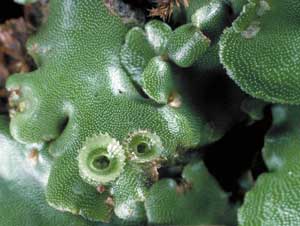 On the right is a photo of a thallose liverwort in the genus Marchantia. Once again there is a flattish growth, very much like that of a foliose lichen, and there are also a couple of shallow, cup-like outgrowths. Could these be apothecia? No, they are gemma cups. That photo showed empty gemma cups but initially those cups are filled with tiny green discs
On the right is a photo of a thallose liverwort in the genus Marchantia. Once again there is a flattish growth, very much like that of a foliose lichen, and there are also a couple of shallow, cup-like outgrowths. Could these be apothecia? No, they are gemma cups. That photo showed empty gemma cups but initially those cups are filled with tiny green discs ![]() , called gemmae. Gemmae are means of vegetative reproduction. They are readily splashed or washed out of the cups and each gemma is capable of developing into a new Marchantia.
, called gemmae. Gemmae are means of vegetative reproduction. They are readily splashed or washed out of the cups and each gemma is capable of developing into a new Marchantia.
In the bulk of foliose lichen species the thallus is layered internally. The uppermost layer is thin and composed of densely packed fungal tissue. Below that is the photobiont layer, green if algal and bluish-green if cyanobacterial. Below that is a thicker layer of loosely arranged fungal tissue and finally, at the bottom, there's often another layer of densely packed fungal tissue. If you carefully scratch the upper surface of a lichen thallus with a needle you'll expose the green or blue-green photobiont layer. If you scratch past that you'll expose the next fungal layer, typically white. You won't find a white layer inside the thallus of a hornwort or a thallose liverwort.
Algae and cyanobacteria
Lichens vary greatly in form and though most have some substance to them there are a few genera with a more wispy appearance, somewhat like cotton-wool teased out to some degree. Such a growth form is described as byssoid and a sterile byssoid lichen could be mistaken for an alga. Conversely, you might mistake some algae for sterile lichens especially since some algae are fairly common in terrestrial habitats. Here ![]() is a red alga on a twig.
is a red alga on a twig.
Cyanobacteria vary in shape and are bluish-green to khaki-coloured when moist, but brittle and blackish when dry. You may sometimes see cyanobacteria mistakenly called 'blue-green algae', but cyanobacteria are quite distinct from algae. The photos (below) show a cyanobacterium in the genus Nostoc, on the left (both dry and wet) and a lichen in the genus Collema on the right. The lichen is fertile, for all those white discs are apothecia, and so is easy to recognize as a lichen. However, were it infertile you might find it difficult to distinguish the Collema from the Nostoc, for both have similar hues and are fleshy when wet and brittle when dry. The Collema has a cyanobacterial photobiont.
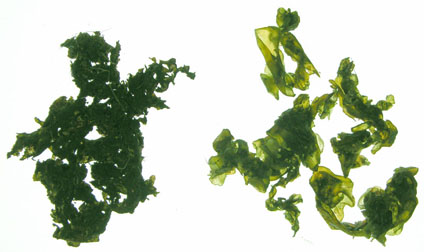 |
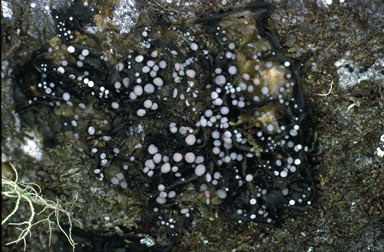 |
![An Australian Government Initiative [logo]](/images/austgovt_brown_90px.gif)


